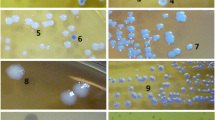Abstract
A new selective medium, sulphite-polymixin-milk (SPM) agar, for the isolation of clostridia from faeces is described. This medium contains whole cow's milk, which favours the growth of clostridia over that ofBacteroides andBifidobacterium spp., and only small amounts of colistin (10μg/ml) for suppressing growth of coliforms. The alkaline end-products of clostridia give rise to yellow colonies on a red background which are easy to distinguish from the red colonies of other not completely inhibited bacteria. The medium is suitable for isolation of many clostridia species. Comparisons were made between SPM and several other media for recovery of clostridia. The detection limit on SPM agar was more than 103 below that on Reinforced Clostridia Agar (Oxoid CM101).
Similar content being viewed by others
References
Finegold, S. M.: Taxonomy, enzyme and clinical relevance of anaerobic bacteria. Reviews of Infecious Diseases 1979, 1: 248–252.
Van der Waay, D., Berghuis-de Vries, J. M., Lekkerkerk-Van der Wees, J. E. C.: Colonization resistance of the digestive tract in conventional and antibiotic treated mice. Journal of Hygiene 1971, 69: 408–412.
Polk, B. F., Kasper, D. L.:Bacteroides fragilis subspecies in clinical isolates. Annals of Internal Medicine 1977, 86: 569–571.
Bartlett, J. G., Chang, T. W., Taylor, N. S., Onderdonk, A. B.: Colitis induced byClostridium difficile. Reviews of Infectious Diseases 1979, 1: 270–278.
Van der Wiel-Korstanje, J. A. A., Winkler, K. C.: The faecal flora in ulcerative colitis. Applied Microbiology 1975, 8: 491–501.
Vargo, D., Moskovitz, M., Floch, M. H.: Faecal bacterial flora in cancer of the colon. Gut 1980, 21: 701–705.
Handford, P. M.: A new medium for the detection and enumeration ofClostridium perfringens in foods. Journal of Applied Bacteriology 1974, 37:559–570.
George, W. L., Sutter, V. L., Citron, D., Finegold, S. M.: Selective and differential medium for isolation ofClostridium difficile. Journal of Clinical Microbiology 1979, 9: 214–219.
Angelotti, R., Hall, H. E., Foter, M. J., Lewis, K. H.: Quantitation ofClostridium perfringens in foods. Applied Microbiology 1972, 10: 193–199.
Gibbs, P. A.: The detection ofClostridium welchii in the differential Reinforced Clostridial Medium Technique. Journal of Applied Bacteriology 1973, 36: 23–33.
Lindner, J. G. E. M., Marcelis, J. H.: Quantitative gas chromatography ofBacteroides species under different growth conditions. Antonie van Leeuwenhoek 1978, 44: 1–14.
Holdeman, L. V., Cato, E. P., Moore, W. E. C.: Anaerobe laboratory manual. Virginia Polytechnic, Blacksbury/VA, 1977.
Marshall, R. S., Steenbergen, J. F., McClung, L. S.: Rapid technique for enumeration ofClostridium perfringens. Applied Microbiology 1965, 13: 559–563.
Miles, A. A., Misra, S. S., Irwin, J. O.: The estimation of bactericidal power of the blood. Journal of Hygiene 1938, 38: 732–750.
Dezfulian, M., McCroskey, L. M., Hatheway, C. L., Dowel, V. R.: Selective medium for isolation ofClostridium botulinum from human faeces. Journal of Clinical Microbiology 1981, 13: 515–531.
Drasar, B. S., Jenkins, D. J. A.: Bacteria diet and large bowel cancer. American Journal of Clinical Nutrition 1976, 29: 1410.
Moore, W. E. C., Cato, E. P., Holdemann, L. V.: Anaerobic bacteria of the gastronintestinal flora and their occurrence in clinical infections. Journal of Infectious Diseases 1969, 119: 641–649.
Mitsuoka, T., Ohno, K., Benno, Y., Suzuki, K., Namba, N.: Die Faekalflora bei Menschen. IV. Vergleich des neu entwickelten Verfahrens mit bisherigen üblichen Verfahren zur Darmflora Analyse. Zentralblatt für Bakteriologie und Hygiene (A) 1976, 234: 219–244.
Author information
Authors and Affiliations
Rights and permissions
About this article
Cite this article
de Vos, N., Mevissen-Verhage, E., van Amerongen, W.H. et al. A new selective medium for the culture of clostridia from human faeces. Eur. J, Clin. Microbiol. 1, 267–271 (1982). https://doi.org/10.1007/BF02019969
Issue Date:
DOI: https://doi.org/10.1007/BF02019969



